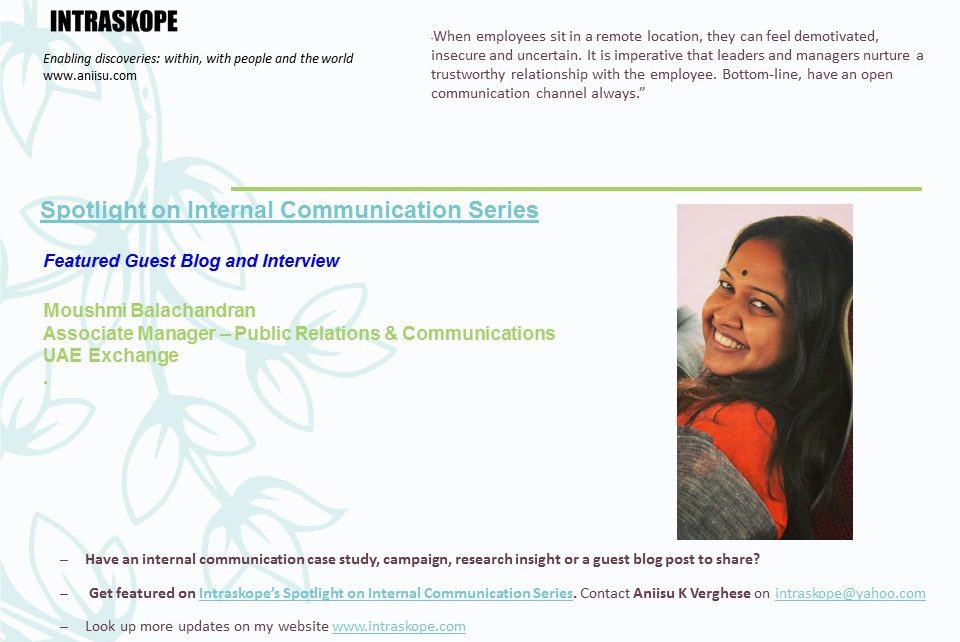The 28th edition of Intraskope’s Spotlight on Internal Communication Series features Moushmi Balachandran of UAE Exchange. Moushmi addresses an important topic for organizations with geographically distributed teams. She shares perspectives on engaging remote staff.
Moushmi Balachandran works for a global financial services provider for expatriates. She has close to 10 years’ experience in marketing and communications, and handles strategic, leadership and internal communications in her current organisation. An MBA graduate and a Finance major from Ohio University, Moushmi quips she is passionate about communications and is intrigued by the dynamism and challenges it offers as a stream.
Guest Blog
(Views expressed are personal)
Engaging remote employees
I’ll cut right to the chase, and the answer is maybe not (the ‘why’ is in the next paragraph). Chances are not more than half of your remote employees (either sitting in an offshore unit or another country operation different from the Global Headquarters) have a birds-eye-view of the company, unless they are in critical teams such as strategy, digital media etc. Remote employees are predominantly absorbed in their own day-to-day projects and are not privy to the company’s milestones and updates because of this.
We all know how important communications is to the effective functioning of an organisation. Today, with companies expanding across the globe, it is practically not possible to have one single office. Several organizations also have offshore services established to cut costs and hope to turn it into a ‘center of excellence’.
Companies that have multiple operations across the globe must somehow ensure they work twice as much to ensure that employees sitting in Boston understand what is happening in Brussels. There is no room for assumption here and unless the organisation takes it upon itself to communicate, the employee will not know and might not even care.
In case you are wondering why employees working in a remote location, should be as informed as the ones in global headquarters, here are the reasons:
- Organizations that have an offshore, shared services unit – largely depend on the contribution of the latter. Most work that has done – is a combined effort between the GHQ and the remote office.
- If the employee working in a remote location does not understand or is not participating in all the action, there’s a high probability that the output may not be comprehensive, impeding optimal productivity.
- Most of the employees working in a remote location, may not have visited the main office or headquarters and this is a hindrance to understanding the management, business and stakeholders.
- If points 2 and 3 happens often, there are high chances that the
- employee is likely to lose his or her interest and purpose, and might just start looking for another job.
Now that I have given enough reasons, I’ll move on to ways we can engage remote teams. Here are some tips to prepare a robust communications strategy for your remote employees.
- Don’t assume
I have said this before, and I will say it again. It’s only natural to think that your colleague sitting in shared services will know about the product launch that you launched in Head Office a couple of days ago. You could not be more wrong. Unless the person has worked on the particular product or its launch, I can safely say the individual has no clue.
- Make use of digital channels
Have TV screens in the office? Share pictures and updates on every town hall, product launch, and new-country expansion. This may work a little more effective in terms of reach, since audiovisual content is still a preferred mode of communication.
- Have frequent meetings
Organize an update or a town hall and do it diligently. Usually town hall meetings happen only if there’s a milestone achieved. I think even the less-significant details must be shared with remote employees. Have trouble getting them together? Make it an employee engagement activity and organize it on a Friday evening.
- Get managers to stay connected
It’s an open secret that employees leave their bosses and not the organizations they work for. This is a double whammy if the bosses are not aware of the responsibility that lie with them. For an employee who sits far from ground zero, their reporting heads have to ensure they are constantly talking to each other. It is the manager’s ownership to give periodiic updates. This can be a weekly call, or a daily update call, depending on mutually agreed time slots. Also, when an employee sits in a remote location, there are lot of chances the individual feels demotivated, insecure and a general sense of uncertainty looms every now and then. It is imperative that managers nurture a trustworthy relationship with the employee. Bottom-line, have an open communication channel, always.
- Involve remote employees in all events
It is OK if the product launch is happening in a different country. We still have Webex and several other virtual connecting platforms through which cross-border participation can happen. So loop in the remote teams. Initially it might be difficult to get everyone to participate, but this is an on-going effort that the management and the local HR partner have to undertake.
It is never too late to start. Why don’t you begin with a quick informal surprise quiz to your team sitting in a remote location? Ask them just five simple ‘yes’ or ‘no’ questions about any major milestone update about the company or about another function. There you go. You have a place to start!
Interview
- What does internal communication mean to you?
Internal communications is a critical function of any company and is about getting the message to staff using all forms of channels – phone, memos or classified boards.
- What is the biggest challenge you face while going about managing internal communication?
Making stakeholders understand the importance of internal communications. Also maintaining consistency in executing the plan and driving connection for a global company present in numerous countries.
- What according to you is the biggest opportunity that internal communicators have?
With the current state of digitization that is transformation very field possible, connecting people and communicating effectively is real. In addition, using analytic tools, one can understand the effectiveness of communications.
- How can internal communicators add more value to the business?
Well-defined internal communications means better-informed and engaged employees, resulting in improved productivity.
- What is your advice for people who are keen to join internal communication and make a career? What skills must they have or develop?
It is an intriguing stream since employees are more demanding than customers are. Good understanding of human psychology and a passion to communicate with empathy are must-have skills.
Missed previous stories from organizations featured on the Intraskope’s Spotlight on Internal Communication Series? Look them up here – Apeland, M.H. Alshaya Co, Proctor & Gamble, Infosys, SOBHA Ltd., ICICI Securities, First Advantage, CK Birla Group, TVS Motors, GE, Suzlon, Tata Sons, Percept, Knight Frank, TCS Europe, Vedanta, Oxfam, Danske Bank, Diageo, Pandora, Symantec, ISS Global Services, Telia, Thomson Reuters, IBM, General Motors and Philips.
Intraskope (www.aniisu.com) is the first blog on internal communications in India and among the earliest around the globe. Begun in 2006, the blog has over 550 posts on topics such as employee engagement, leadership communication and employee branding and receives thousands of visits from across the world. The blog, receives over 50,000 visits every month from over 50 countries globally, offers learning resources for practitioners, academicians, and students including industry workshops, research reports, and checklists. Intraskope has been featured on leading global internal communication forums like Simply-Communicate, IC Kollectif and International Association of Business Communicators. It is hosted by Aniisu K Verghese, author of Internal Communications – Insights, Practices & Models (Sage, 2012).
If you are an internal communication leader working in a firm or a not-for-profit anywhere in the world and have an internal communication case study, campaign, research insight or a guest blog post to share please contact me on [email protected]
You can also visit my website www.intraskope.com and You Tube channel to know more about my work



